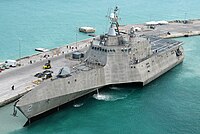
Photo from wikipedia
Abstract The flow-sediment interaction plays a considerable role on the vertical (internal) profiles of current, salinity and suspended sediment concentration (SSC) within a turbidity maximum zone (TMZ). Numerical modeling provides… Click to show full abstract
Abstract The flow-sediment interaction plays a considerable role on the vertical (internal) profiles of current, salinity and suspended sediment concentration (SSC) within a turbidity maximum zone (TMZ). Numerical modeling provides valuable insights into the complex estuarine physical processes. By combining numerical modeling with field observations, the influencing factors of fine sediment dynamics within the TMZ of Yangtze Estuary have been explored in this study. Firstly, during the neap tide, the measured data present that the current is too weak to break the density stratification, and the vertical flow structure is effectively altered. Secondly, a three-dimensional numerical model based on the Delft3D has been developed and a range of numerical sensitivity analyses were carried out to distinguish the dominant mechanisms and physical processes responsible for the phenomena observed from the measurement data. The numerical investigation highlights the following findings. (1) The vertical profile of currents within the TMZ is largely affected by saltwater intrusion, especially during lower currents when the baroclinic pressure gradient can significantly reshape the local vertical profiles of velocity. (2) The baroclinic effects are primarily determined by the stratification of salinity. (3) In addition to salinity, SSC also influences the local density stratification when its contribution to fluid density is comparable to that of salinity. (4) The settling velocity determines the overall sediment distribution and vertical profiles of the SSC in the water column. The SSC-dependent settling velocity (including the flocculation-induced acceleration and hindered settling deceleration phases) affects the longitudinal movement of the sediments. (5) The vertical profiles of current, salinity and SSC within the TMZ are highly associated with the turbulence determined by the model. The approach to modulate the vertical eddy viscosity in the model, based on the empirical dependency between Ri g and Pr t , may lead to a numerical instability in the stratified flow. In order to improve the stratification of SSC, additional turbulence damping effect is suggested to be implemented in the model.
Journal Title: International Journal of Sediment Research
Year Published: 2017
Link to full text (if available)
Share on Social Media: Sign Up to like & get
recommendations!